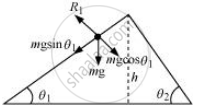Advertisements
Advertisements
प्रश्न
A solid sphere rolls down two different inclined planes of the same heights but different angles of inclination. (a) Will it reach the bottom with the same speed in each case? (b) Will it take longer to roll down one plane than the other? (c) If so, which one and why?
उत्तर १
(a) Yes (b) Yes (c) On the smaller inclination
(a)Mass of the sphere = m
Height of the plane = h
Velocity of the sphere at the bottom of the plane = v
At the top of the plane, the total energy of the sphere = Potential energy = mgh
At the bottom of the plane, the sphere has both translational and rotational kinetic energies.
Hence, total energy = `1/2mv^2 + 1/2Iomega^2`
Using the law of conservation of energy, we can write:
`1/2mv^2 + 1/2 Iomega^2 = mgh` ....(I)
For a solid sphere, the moment of inertia about its centre, `I = 2/3 mr^2`
Hence, equation (i) becomes:
`1/2 mv^2 + 1/2 (2/5 mr^2)omega^2 = mgh`
`1/2v^2 + 1/5r^2omega^2 =gh`
But we have the relation `v= r omega`
`:.1/2v^2 + 1/5v^2 = gh`
`v^2(7/10) = gh`
`v = sqrt(10/7 gh)`
Hence, the velocity of the sphere at the bottom depends only on height (h) and acceleration due to gravity (g). Both these values are constants. Therefore, the velocity at the bottom remains the same from whichever inclined plane the sphere is rolled.
(b), (c)Consider two inclined planes with inclinations θ1 and θ2, related as: θ1 < θ2
The acceleration produced in the sphere when it rolls down the plane inclined at `theta_1` is g sin `theta_1`
The various forces acting on the sphere are shown in the following figure.

R1 is the normal reaction to the sphere.
Similarly, the acceleration produced in the sphere when it rolls down the plane inclined at θ2is:
g sin θ2
The various forces acting on the sphere are shown in the following figure.

R2 is the normal reaction to the sphere.
θ2 > θ1; sin θ2 > sin θ1 ... (i)
∴ a2 > a1 … (ii)
Initial velocity, u = 0
Final velocity, v = Constant
Using the first equation of motion, we can obtain the time of roll as:
v = u + at
`:. t prop 1/a`
`[("For inclination" theta_1: t_1 prop 1/a_1), ("For inclination" theta_2 : t_2 prop 1/a_2)]` ...(iii)
From equations (ii) and (iii), we get:
t2 < t1
Hence, the sphere will take a longer time to reach the bottom of the inclined plane having the smaller inclination
उत्तर २
(a) Using law of conservation of energy,
`1/2mv^2 + 1/2Iomega^2 = mgh`
or `1/2mv^2 + 1/2(2/5 mR^2) v^2/R^2 = mgh`
or 7/10v^2 = gh or v = `sqrt((10gh)/7)`
Since h is same for both the inclined planes therefore v is the same.
b) `l = 1/2((g sin theta)/(1+K^2/R^2)) t^2 = (g sin theta)/2(1+2/5) t^2 = (5g sin theta)/14 t^2`
or t = `sqrt((14l)/(5g sin theta)`
Now, `sin theta = h/l` or l = `h/sin theta`
`:. t= 1/sin theta sqrt((14h)/"5g")`
Lesser the value of `theta` more will be t
c) Clearly, the solid sphere will take longer to roll down the plane with smaller inclination.
APPEARS IN
संबंधित प्रश्न
Read each statement below carefully, and state, with reasons, if it is true or false;
A wheel moving down a perfectly frictionless inclined plane will undergo slipping (not rolling) motion
A stone of mass 2 kg is whirled in a horizontal circle attached at the end of 1.5m long string. If the string makes an angle of 30° with vertical, compute its period. (g = 9.8 m/s2)
A hollow sphere and a solid sphere having same mss and same radii are rolled down a rough inclined plane.
A sphere can roll on a surface inclined at an angle θ if the friction coefficient is more than \[\frac{2}{7}g \tan\theta.\] Suppose the friction coefficient is \[\frac{1}{7}g\ tan\theta.\] If a sphere is released from rest on the incline, _____________ .
A string is wrapped over the edge of a uniform disc and the free end is fixed with the ceiling. The disc moves down, unwinding the string. Find the downward acceleration of the disc.
A hollow sphere is released from the top of an inclined plane of inclination θ. (a) What should be the minimum coefficient of friction between the sphere and the plane to prevent sliding? (b) Find the kinetic energy of the ball as it moves down a length l on the incline if the friction coefficient is half the value calculated in part (a).
What is the condition for pure rolling?
A uniform disc of mass 100g has a diameter of 10 cm. Calculate the total energy of the disc when rolling along with a horizontal table with a velocity of 20 cms-1. (take the surface of the table as reference)
A solid sphere of mass 1 kg and radius 10 cm rolls without slipping on a horizontal surface, with velocity of 10 emfs. The total kinetic energy of sphere is ______.
If x = at + bt2, where x is the distance travelled by the body in kilometers while t is the time in seconds, then the unit of b is ______.
